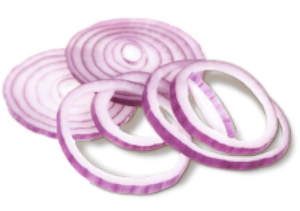Cheap Eats:
Cebollas Encuridas
(Yucatecan Pickled Onions)
The allium genus includes some of my favorite purveyors of flavor, including garlic, shallots, leeks, scallions and onions. It’s hard to imagine cooking without those fragrant, vibrant plants. And in fact, no one ever has to, since wild members of the allium genus grow worldwide. That’s why, even though onions as we know them arrived with European explorers, we still ended up with Indian words that refer to a place where wild onions were causing a stink: the Potawatomi word checagou, which means “place that stinks of wild onions,” and the Menominee word shika’ko, meaning “skunk place,” which actually referred to the smell of the wild onions. We’re not sure which of these words was the derivation of Chicago, but the point is, there were a lot of wild onions growing here long before domesticated onions made it over with European settlers.

Of the 325 species within this genus, onions are probably the most widely ones used today. It’s hard to pinpoint its origin and scholars disagree on its starting point, but let’s just say “the Old World,” because it was somewhere around Central Asia or the Middle East or maybe even the eastern Mediterranean that it first came into use. Fortunately, with the rise of civilization, onions became easier to track. The Sumerians were writing about them in cuneiform around 3000 BC. Mesopotamians loved onions, too. Hammurabi considered onions so important that, in his famous code, he stipulated a monthly ration of them for the poor. They were commonly sliced and eaten raw on bread.
The Egyptians were great onion eaters, too and the onion is the plant that appears most often in Egyptian art. (They didn’t just eat onions; but when preparing a corpse for burial, Egyptians used small onions to replace eyeballs in mummies.)
The man on the street in ancient Rome was addicted to raw onion on bread for breakfast and while the Romans viewed onions as largely for the average to low-class citizen, the cookbook author, Apicius, who wrote for the wealthy, used onions in his sauces.
Chinese loved and love onions. The “three strong-flavored seasoners” of Beijing-style cooking are onions, garlic and ginger.
Appreciation of onions was widespread in England by the 1200s at the latest and by Elizabethan times, onions and leeks were the most popular vegetables in England. So it’s not too surprising that the British brought onions with them to the New World. The first known planting of the introduced Eurasian Allium cepa was in Massachusetts in 1648. Even though the Americas have numerous varieties of wild onion, it is the Allium cepa that has become the dominant onion in the United States.
In Mexico’s Yucatán, pickled red onions are served at almost every meal, appearing as soon as you sit down, along with the salsa. They are a delightful and delicious way to enhance foods, from simply piling them on tortilla chips to using them to enhance your food. I came to be fairly addicted to them when I toured the Yucatán a few years ago and I now make them regularly.
And just so you know, these are good with more than just Mexican food. Almost anywhere you’d use pickles, relish, or onions can be enhanced with this flavorful condiment. Enjoy.
Cebollas Encuridas
(Yucatecan Pickled Onions)
1 large red onion, thinly sliced
Boiling water, to cover
¼ tsp. freshly ground pepper
½ tsp. salt (or to taste)
2 cloves garlic, minced
½ cup sour orange juice (see Note below), or to cover
½ tsp. dried oregano, perferably Mexican
Pour boiling water over the sliced onions. Let sit one minute. Drain, discard the water. Put the onion in a non-reactive container and add the rest of the ingredients. Let sit for at least one hour, but preferably overnight. Depending on the size of the onion, makes 1 to 1½ cups of pickled onion.
Notes:
You must use sour orange juice. It’s completely different from sweet orange juice—more like lime. Straight vinegar would be better than using sweet orange juice, but look for sour orange in the Hispanic- or Mexican-foods aisle of your grocery store, or in a Hispanic grocery. It’s worth the effort, because the flavor really is different if you try substitutes for the sour orange.
If I’m pressed for time, which is almost always, I’ll grab the Mojo Criollo that I almost always have on hand and use that in place of everything except the onion. This great marinade can be found at any Hispanic grocery store and it contains most of the ingredients listed above: sour orange, garlic, salt, pepper, and “herbs.” The difference in the result is close to unnoticeable, so feel free to take the easy way out.

